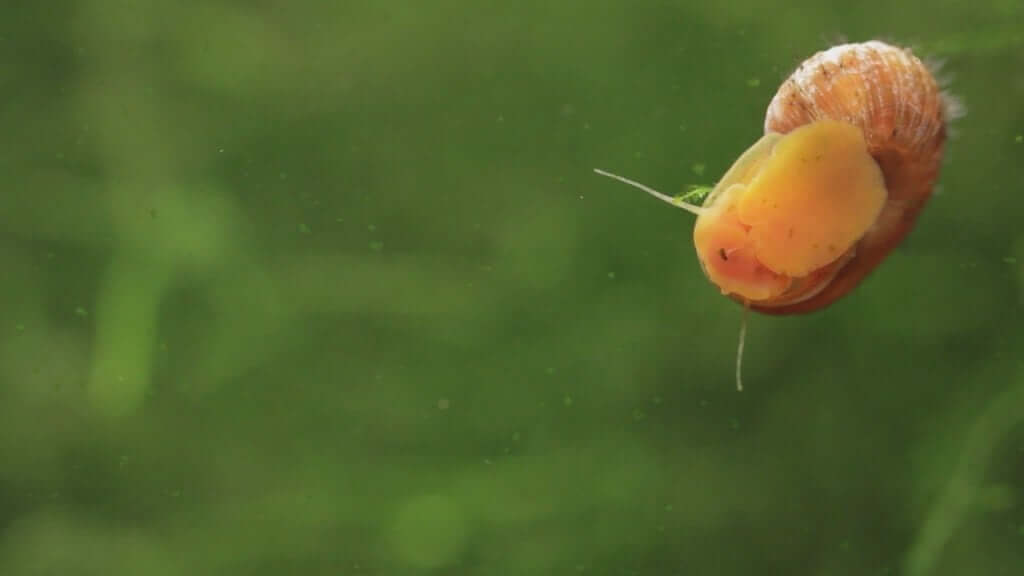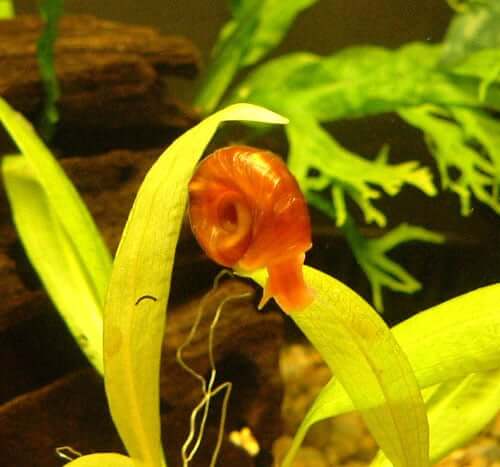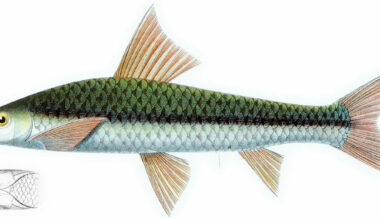The Ramshorn Snail is a critter we really enjoy. They’re super easy to care for and quite fun to watch!
You’ll be surprised how much time you end up watching these little creatures move around your tank. They’re always on a mission to find and munch on algae.
We recommend these snails to other aquarists all the time, and we know a handful who swear they’ll never keep a tank without one!
This guide will show you everything you need to know about Ramshorn Snail care. We also cover breeding in-depth as well (spoiler alert: it’s pretty easy to do) so feel free to skip to the end if you’re specifically looking for that info.
Table of Contents
Species Summary
Ramshorn Snails (the Planorbidae family) are an interesting addition to established tanks. While many aquarists purposefully introduce them into freshwater aquariums, many enter the ecosystem by accident!
They tend to hitchhike on live plants and rocks. As a result, they’re pretty widespread in the fish-keeping world.
Interestingly enough, Ramshorn Snails aren’t that easy to find in the wild. Some can be found living in streams and small ponds. However, most are seen in the aquarium trade.
Whether you have purchased a Ramshorn Snail to keep as a pet or you have a new unexpected addition to your tank, keeping these snails healthy is very simple. They’re hardy creatures that will serve a functional purpose in your tank.
Lifespan
Generally, the average Ramshorn Snail lifespan is only about a year.
That said, they can live longer. Many seasoned aquarists have seen these snails live to be about 3 years old with optimal water conditions.
While they might be hardy, these snails do need stable living conditions and plenty of access to high-quality foods. You can extend their life expectancy significantly by addressing their unique needs directly.
Appearance
There’s a lot of variety when it comes to the appearance of Ramshorn Snails. Both the shell and the skin of the snail can be different, opening up a world of possibilities for color combinations.

Typically, the skin of the snail can either be black or red. Black snails have melanin pigment while the red ones don’t. The reason why red snails take on their vibrant color is because of their blood. Unlike other snail species, the Ramshorn Snail has blood with red hemoglobins.
Now, onto the shell. These snails get their name from the distinct shape the shell takes on. It features a flat spiral. It’s reminiscent of a rope spiral or ram’s shorn.
Shell colors can vary widely. The most common hues you’ll see are shades of light or dark brown. However, more vibrant specimens may have blue shells, red shells, and even spotted shells.
The cool thing about Ramshorn Snails is that their shells will grow as they get bigger.
As juveniles, the shells are thin and somewhat transparent. With a good diet, the shell will harden and become more opaque as the snail grow.
The spiral may also become bigger with time. The shells spiral to the side. In the center of the spiral, there’s a hole. You might even see some skin poking out of the hole from time to time.
While most snails that live underwater have an operculum, Ramshorn Snails do not. The operculum is a trapdoor on the bottom of the shell that’s present with most marine and freshwater snails.
The reason that Ramshorn Snails don’t have one is that they actually breathe air. They rely on oxygen to survive. Typically, the operculum is meant to block air out in times of drought, so having one would be impractical to air-breathing snails like the Ramshorn.
Size
The average Ramshorn Snail size is about one inch in diameter (that’s how you measure the size of a snail). These little critters aren’t very big at all are only slightly larger than a dime!
Author Note: There is some evidence to suggest that the quality of care they receive can impact their maximum size. We know a couple of aquarists who take fantastic care of their Ramshorn Snails and most of them exceed the one-inch mark.
Ramshorn Snail Care
As we mentioned earlier, Ramshorn Snail care shouldn’t give you any issues. They’re highly adaptable creatures that can thrive in most environments.
That said, that doesn’t mean you can afford to get complacent when it comes to water quality and their environment. If you want these snails to grow big and stay healthy, you should be committed and serious about maintaining their habitats.
Tank Size
The great thing about Ramshorn Snails is that you don’t need tons of room to care for them. They only require a tank size of around 5 gallons at a minimum.
However, we recommend starting with a 10-gallon tank if you plan on keeping multiple snails (as many do).
Despite their slow and steady nature, these snails do like to roam around the aquarium. Having more space facilitates natural feeding as well, which is a big plus.
Water Parameters
Ramshorn Snails prefer very moderate waters, which is good for aquarists. There aren’t any odd conditions that you have to provide, it’s more about consistency. These snails do not like environments where conditions can change quickly.
Great water conditions are crucial for these freshwater snails in two different ways. The first is that it will impact the health of the snail directly. The second is it allows their shells to grow big and strong (which is very important).
The good news is that the snails can adapt to a range of conditions. They do well in crystal-clear waters and murky habitats alike.
For the best results, here are some parameters to stick to.
- Water temperature: 70°F to 78°F
- pH levels: 7.0 to 7.5
- Water hardness: 5 to 15 dKH
In order to maintain consistency with the water in their tank, come up with a schedule for performing water tests and water changes. This is something that you can work around the needs of other animals in the aquarium (if it’s a community tank) first since these animals are flexible.
What To Put In Their Tank
There’s not a whole lot that you have to do to keep Ramshorn Snails happy when it comes to decorations. Unlike many fish, you don’t need to concern yourself with creating hiding spots or breeding areas.
You can, however, benefit from having lots of live plants in the tank. Ramshorn Snails love to hang out on plant leaves.

There is some contention in the fish-keeping community about whether or not these snails can live with live plants. One side thinks that they destroy live plants by eating them while others have had no problems in that area.
Here’s where we stand:
Ramshorn Snails are perfectly capable of eating live plants. However, they’ll only do so if they aren’t getting enough food elsewhere. If you provide your snails with a decent diet, they’ll leave the plants alone.
As for equipment, standard filtration is suitable. A traditional canister or HOB filter should work just fine. As long as the filter is powerful enough to keep nitrate levels low you’re in good shape.
Like most snails, the Ramshorn is susceptible to high nitrate and ammonia levels, so your filter must cycle the water efficiently.
Common Possible Diseases
With Ramshorn Snails, it’s not a matter of what diseases they’ll suffer from but what diseases they’ll bring into your tank.
These snails are quite resilient. Major diseases aren’t a huge problem. However, they are notorious for introducing diseases into a community tank.
When you buy them from the store, they can have parasitic skin flukes. Snails are the perfect host for these parasites. To make matters worse these are difficult to see, so you may not even realize you’re putting other fish at risk until it’s too late.
Flukes can latch onto the sides of other fish to feed. This results in stress and other major health complications.
If you’re getting new Ramshorn Snails, we recommend putting them in a quarantine tank for about a month to ensure that you’re not putting the larger fish community at risk.
Author Note: It’s important to point out that if you add medicine to your tank it should be copper-free. Copper and snails don’t get along, and will likely result in the death of your Ramshorn.
If adding something that contains copper is unavoidable we recommend moving your Ramshorn Snails to another tank ((with matching water conditions of course) until all traces of it are out of the water.
Food & Diet
Ramshorn Snails will spend most of their time looking for aquarium algae to eat. It’s fun to watch them scour your tank for something to munch on!
Usually, they’ll find algae on the sides of your tank. So, they’ll climb up the glass to feed and keep your aquarium clean.
Aside from algae, Ramshorn Snails love to feed on decaying plant matter. They’ll consume leaves that fall off your aquatic plants.
The snails will even eat dead fish and shrimp if given the chance. Though, we don’t recommend leaving dead critters in your tank as it can cause major water problems.
To supplement your snail’s diet, you can provide some commercial foods, too.
They’ll eat leftover fish flakes and pellets that fall to the bottom of the tank. You can also provide algae wafers and calcium fish supplements. The latter will strengthen their shells.
Some basic vegetables are a good choice as well. They’ll eat things like lettuce and cucumbers.
When you feed the snails, only provide them with as much food as they can eat in 5 minutes. Remember, they’ll constantly feed on algae in the tank, so you don’t want to overfeed them!
Behavior & Temperament
For the most part, Ramshorn Snails will keep to themselves. They’re peaceful and don’t cause any trouble to other fish.
Despite what some people assume, they’re actually quite active and will roam the tank day and night in search of food. You might spot your snails climbing on the glass walls or hanging delicately from a plant leaf.
One interesting behavioral quirk about these snails is that they can often feed in groups. When one snail finds a good source of food, it’s only a matter of time before the rest of them come out of the woodworks to share a meal.
Tank Mates
Ramshorn Snails are often the target of aggressive fish. Several species will eat these mollusks any chance they get.
If you want to keep your snail population healthy, stick to non-aggressive fish. You can also introduce other peaceful snails (like the Mystery), clams, and peaceful shrimp into the mix.
Here’s a list of some peaceful tank mates for the Ramshorn Snail:
- Cory Catfish
- Dwarf Gourami
- Celestial Pearl Danio
- Guppies
- Chili Rasbora (and other rasboras)
- Honey Gourami
- Ghost Shrimp
- Pearl Gourami
- Cherry Shrimp
When it comes to planning tank mates for Ramshorn Snails it’s important to realize that these snails can quickly overrun a tank if you’re not careful. Thanks to their frequent spawning, it can be a challenge to keep the population under control.
Author Note: In that case, some aquarists like to include fish species that will eat the snails every once in a while. You can also use a predatory snail species, such as the Assassin Snail to keep the numbers low.
Ramshorn Snail Breeding
Ramshorn Snails breeding is quite easy. This species reproduces frequently and will do this without much help from you!

They lay eggs so often that it doesn’t take long for the snail population to increase dramatically in a small tank.
These snails are hermaphrodites. This means that they have both sexual organs.
As a result, there isn’t a requirement to have a male and female snail. They can breed with any other snail, making the process quick.
When they breed, the snails will lay numerous egg clusters throughout the tank. They’re often well-hidden. However, you might see some on plant stems.
Usually, the clusters contain about 12 clear eggs. After several days, the baby snail inside will be visible. Not long after that, the tiny snails will emerge from the eggs and immediately look for food to eat.
You don’t have to worry about feeding the baby Ramshorn Snails, as they’ll find soft algae on their own!
Conclusion
Even though they’re “just a snail” the Ramshorn is a species that we’ve grown attached to over the years. There’s something about the way these critters keep to themselves and stay busy that’s really endearing!
Now that you know the essentials of Ramshorn Snail care, it’s time for you to get some for yourself. This species is about as low-maintenance as it gets, and a purchase you won’t regret.
If you’re a Ramshorn Snail owner who wants to share info, stories, or photos we’d love to hear from you. We’re always looking for interesting ways to spruce up our care guides.

